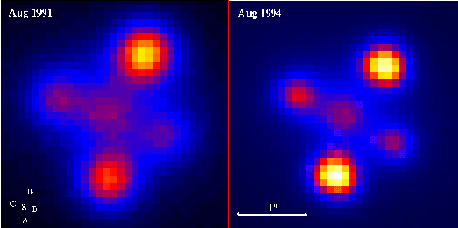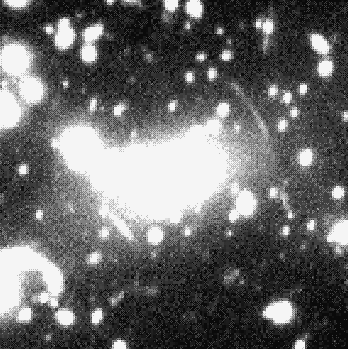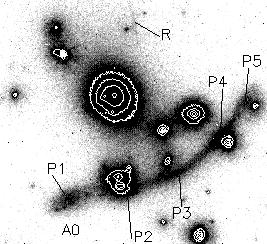Galaxy as Gravitational Lens

Microlensing of the Einstein Cross
Picture Credit: Geraint Lewis and Michael Irwin, William Hershel Telescope
The famous "Einstein Cross" is a case where a single object is seen four times.
Here a very distant
QSO
happened to be placed nearly exactly behind a massive galaxy.
The gravitational effect of the galaxy on the distant QSO light is similar
to the lens effect of a drinking glass on a distant street light -
it creates multiple images.
But stars in the foreground galaxy have been found to act as gravitational lenses here too!
These stars make the images change brightness relative to each other.
These brightness changes are visible on these two photographs of the Einstein Cross,
taken about 3 years apart.
For more information about this picture see the home page of the IAU Symposium 173
Astrophysical Applications of Gravitational Lensing
in Melbourne, Australia 9-14 July, 1995.

A Galaxy Gravitational Lens
Credit: NASA,
HST, K. Ratnatunga. Myungshin Im
(JHU)
Explanation:
Sometimes it takes a keen eye to see a good mirage.
Around the center of the red
galaxy
image in the
above photograph
lie four blue "smudges."
Each smudge is actually a different image of the same background
quasar.
The central galaxy happens to fall directly in the light path of the
quasar.
Consequently, the huge mass of the galaxy is able to pull separate images
of the quasar around it -
an effect called gravitational lensing.
Hence we see a gravitational mirage!
Astronomers have hopes of using light differences between these quasar images
to not only "weigh" the central galaxy but even provide clues about the
expansion rate
and composition
of the universe.

A Galaxy Gravitational Lens
An 8 GHz (radio) map of an Einstein Ring about MG1121+0456, from Chen, Kochanek, and Hewitt (1995).

A Galaxy Cluster Gravitational Lens
Two giant arcs in galaxy cluster Abell 2219, from
Smail et al. 1995.

A Galaxy Cluster Gravitational Lens
Giant arc in galaxy cluster Abell 370, from
Smail et al. 1996.
Gravitational Lens Captures Image of Primeval Galaxy

Credit: W.N. Colley and E. Turner ( Princeton University),
J.A. Tyson (Bell Labs, Lucent Technologies) and
NASA
April 24, 1996
This Hubble Space Telescope image shows several blue, loop-shaped objects
that actually are multiple images of the same galaxy.
They have been duplicated by the gravitational lens of the cluster of yellow, elliptical
and spiral galaxies - called 0024+1654 - near the photograph's center.
The gravitational lens is produced by the cluster's tremendous gravitational field
that bends light to magnify, brighten and distort the image of a more distant object.
How distorted the image becomes and how many copies are made depends on the alignment between the foreground cluster and the more distant galaxy,
which is behind the cluster.
In this photograph, light from the distant galaxy bends as it passes through the cluster,
dividing the galaxy into five separate images.
One image is near the center of the photograph;
the others are at 6, 7, 8, and 2 o'clock.
The light also has distorted the galaxy's image from a normal spiral shape
into a more arc-shaped object.
Astronomers are certain the blue-shaped objects are copies of the same galaxy
because the shapes are similar.
The cluster is 5 billion light-years away in the constellation Pisces,
and the blue-shaped galaxy is about 2 times farther away.
Though the gravitational light-bending process is not new,
Hubble's high resolution image reveals structures within the blue-shaped galaxy
that astronomers have never seen before.
Some of the structures are as small as 300 light-years across.
The bits of white imbedded in the blue galaxy represent young stars;
the dark core inside the ring is dust,
the material used to make stars.
This information, together with the blue color and unusual "lumpy" appearance,
suggests a young, star-making galaxy.
The picture was taken October 14, 1994 with the Wide Field Planetary Camera-2.
Separate exposures in blue and red wavelengths were taken to construct this color picture.
Hubble views Distant Galaxies through a Cosmic Lens

This NASA Hubble Space Telescope image of the rich galaxy cluster, Abell 2218, is a spectacular example of gravitational lensing. The arc-like pattern
spread across the picture like a spider web is an illusion caused by the gravitational field of the cluster.
The cluster is so massive and compact that light rays passing through it are deflected by its enormous gravitational field, much as an optical lens bends
light to form an image. The process magnifies, brightens and distorts images of objects that lie far beyond the cluster. This provides a powerful "zoom
lens" for viewing galaxies that are so far away they could not normally be observed with the largest available telescopes.
Hubble's high resolution reveals numerous arcs which are difficult to detect with ground-based telescopes because they appear to be so thin. The arcs
are the distorted images of a very distant galaxy population extending 5-10 times farther than the lensing cluster. This population existed when the
universe was just one quarter of its present age. The arcs provide a direct glimpse of how star forming regions are distributed in remote galaxies, and
other clues to the early evoution of galaxies.
Hubble also reveals multiple imaging, a rarer lensing event that happens when the distortion is large enough to produce more than one image of the
same galaxy. Abell 2218 has an unprecedented total of seven multiple systems.
The abundance of lensing features in Abell 2218 has been used to make a detailed map of the distribution of matter in the cluster's center. From this,
distances can be calculated for a sample of 120 faint arclets found on the Hubble image. These arclets represent galaxies that are 50 times fainter than
objects that can be seen with ground-based telescopes.
Studies of remote galaxies viewed through well-studied lenses like Abell 2218 promise to reveal the nature of normal galaxies at much earlier epochs
than was previously possible. The technique is a powerful combination of Hubble's superlative capabilities and the "natural" focusing properties of
massive clusters like Abell 2218.
The image was taken with the Wide Field Planetary Camera 2.
Credits: W.Couch (University of New South Wales), R. Ellis (Cambridge University), and NASA
Physics 139 home page






